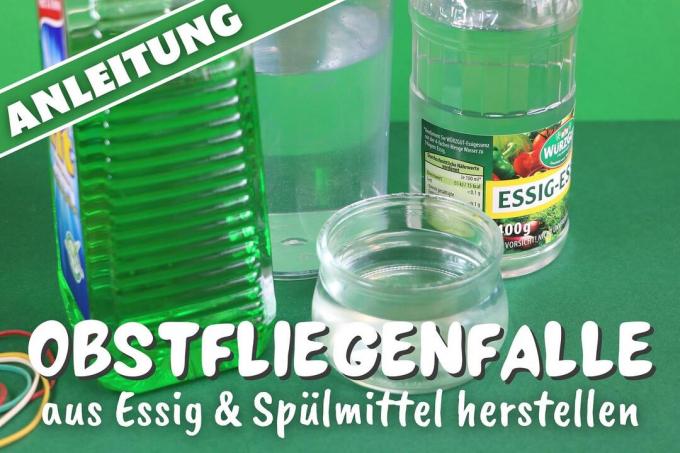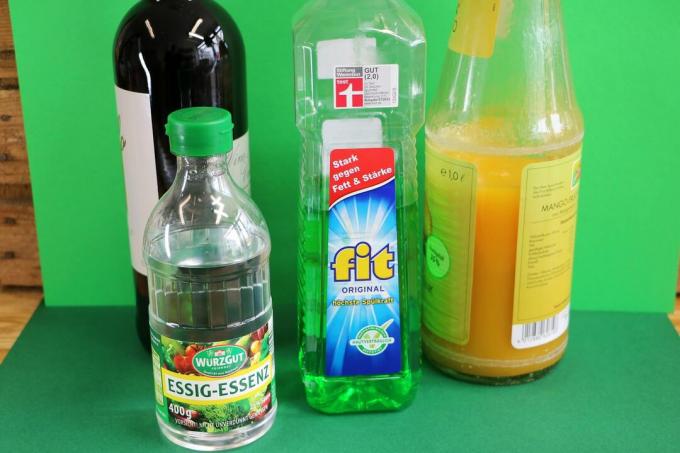
Nobody wants to do without fresh fruit in summer. But be careful, fruit flies also love the aromatic fruits. How to get rid of annoying insects with a homemade fruit fly trap made from vinegar and washing-up liquid.
In a nutshell
- Fruit flies prefer fermentation
- Preference for ripe fruits and sweet drinks
- homemade vinegar traps can help
- preventive measures increase success
contents
- Build your own fruit fly trap
- Suitable vessels
- How the fruit fly trap works
- Prevent fruit flies
- frequently asked Questions
Build your own fruit fly trap
You need:
- Vinegar
- fruit juice
- detergent
- a vessel

Instructions:
- Mix three parts fruit juice with two parts water and one part vinegar.
- Put everything in a jar.
- Add a few squirts of dish soap.
- Stir the mixture.
A notice: When it's warm, the liquid evaporates quickly. Renew the fruit flytrap regularly. We recommend placing multiple traps in affected areas.
Wine as an alternative
You can use wine instead of fruit juice. The use of white wine or rosé wine has proven itself. Of course, red wine has a comparable effect. However, due to the risk of red wine stains and because the small flies are harder to see in the dark wine, we recommend the lighter types of wine.
Suitable vessels
The Hole Trap
For the hole trap you need a flat bowl. Now fill this fruit flytrap with your homemade lure mixture of vinegar, washing-up liquid and juice. Stretch cling film evenly over the rim of the bowl. Poke small holes in it with a skewer. The fruit flies can get in through the holes but not out again.
The funnel trap
For the funnel trap you need a bottle with a larger opening. A 500 milliliter milk bottle, for example, works well.

Fill the bottle with the lure mix and put a regular funnel in it. If you don't have a funnel, you can also roll up paper into a funnel and fix it with tape.
It works in the same way as the pinhole trap, because the flies get into the bottle through the funnel, but not out. Make sure the opening of the funnel is small enough to prevent the insects from escaping.
How the fruit fly trap works
The mode of action of the self-made fruit flytrap made of vinegar and washing-up liquid is simple. Sweet juice and wine, but also the sour smell of vinegar attract the little flies. When the insects get to the tempting meal and settle on the water surface, they drown. Usually light flies can land on the surface of liquids without drowning. However, detergent has the property of destroying surface tension. Because of this, the insects immediately go under and drown.
Prevent fruit flies
Before annoying little fruit flies happily settle on your fruit and vegetables, you should take simple measures to prevent them:
- Don't leave any fruit lying around. Put everything in the fridge in sealable containers.
- Rinse glasses and bottles to completely remove drink residue. Close bottles that are still full securely. The insects are particularly attracted to fruit juices and wine.
- Put a lid on your compost bin. Dispose of leftover food and organic waste regularly.
- Place the compost heap and the compost bin not near windows.

Tip: Only wash fruit just before eating. Washed fruit is more affected by rot. The putrefaction process attracts flies and other vermin.
frequently asked Questions
Apple cider vinegar is just as suitable for making the lure mixture as a mixture of apple juice and vinegar. It is best to choose the ingredients that you already have at home. Apple juice can also be replaced with other fruit juices.
Usually the first fruit flies are caught very quickly. If you set up the fruit fly trap at midday, the first insects should be visible in the solution the next morning.
The concentration of your attractant mixture may not be sufficient. Then increase the proportion of vinegar and fruit juice. The annoying flies often find other food in the area. Get rid of leftover food, ripe fruit and vegetables, and glasses and bottles that have leftovers on them.
Instead of the bait mixture, you can put old chopped banana peels in a bowl and seal with perforated cling film as instructed. When enough flies have collected, you can dispose of them on the compost heap.



